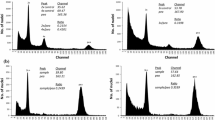Abstract
Ten different tetraploid wheat (Triticum turgidum) genotypes were pollinated with maize (Zea mays). Fertilization was achieved in all ten genotypes and no significant difference in fertilization frequency between the tetraploid wheat genotypes was detected. A mean of 41.1% of pollinated ovaries contained an embryo. All these crosses were characterized by the elimination of the maize chromosomes, and the resulting embryos were haploids. Six of the tetraploid wheat genotypes were also pollinated with Hordeum bulbosum. Fertilization frequencies with H. bulbosum were much lower (mean=13.4%), and significant differences between the tetraploid wheat genotypes were detected. Observation of pollen tube growth revealed that part of the incompatibility reaction between tetraploid wheats and H. bulbosum was due to an effect similar to that of the Kr genes, namely pollen tube growth inhibition. These results indicate that pollinations with maize may have potential as a broad spectrum haploid production system for tetraploid wheats.
Similar content being viewed by others
References
Comeau A, Plourde A, St Pierre CA, Nadeau P (1988) Production of doubled haploid wheat lines by wheat x maize hybridization. Genome 30 [Supp1]:482 (abstr)
Falk DE, Kasha KJ (1981) Comparisons of the crossability of rye (Secale cereale) and Hordeum bulbosum onto wheat (Triticum aestivum). Can J Genet Cytol 23:81–88
Falk DE, Kasha KJ (1983) Genetic studies of the crossability of hexaploid wheat with rye and Hordeum bulbosum. Theor Appl Genet 64:303–307
Hadwiger MA, Heberle-Bros E (1986) Pollen plant production in Triticum turgidum ssp. durum. In: Horn W, Jensen CJ, Odenbach W, Schieder O (eds) Genetic manipulation in plant breeding. EUCARPIA 1985. Watter de Gruyter, Berlin, pp 303–305
Inagaki M, Tahir M (1990) Comparison of haploid production frequencies in wheat varieties crossed with Hordeum bulbosum L. and maize. Jpn J Breed 40:209–216
Krolow KD (1970) Untersuchungen über die kreuzbarkeit zwischen weizen und roggen. Z Pflanzenzuecht 64:44–72
Lange W, Wojciechowska B (1976) The crossing of common wheat (Triticum aestivum L.) with cultivated rye (Secale cereale L.). 1. Crossability, pollen grain germination and pollen tube growth. Euphytica 25:609–620
Laurie DA (1989) Factors affecting fertilization frequency in crosses of Triticum aestivum cv ‘Highbury’ x Zea mays cv ‘Seneca 60’. Plant Breed 103:133–140
Laurie DA, Bennett MD (1986) Wheat x maize hybridization. Can J Genet Cytol 28:313–316
Laurie DA, Bennett MD (1987) The effect of the crossability loci Kr1 and Kr2 on fertilization frequency in hexaploid wheat x maize crosses. Theor Appl Genet 73:403–409
Laurie DA, Bennett MD (1988a) The production of haploid wheat plants from wheat x maize crosses. Theor Appl Genet 70:100–105
Laurie DA, Bennett MD (1988b) Chromosome behaviour in wheat x maize, wheat x sorghum and barley x maize crosses. In: Brandham PE (ed) Kew Chromosome Conference III (Proc 3rd Chromosome Conf 1987). Her Majesty's Stationary Office, London, pp 167–177
Laurie DA, Reymondie S (1991) High frequencies of fertilization and haploid seedling production in crosses between commercial hexaploid wheat varieties and maize. Plant Breed 106:182–189
O'Donoughue LS (1990) Chromosome behaviour and reproductive physiology in cereal wide crosses. PhD thesis, Cambridge University, UK
O'Donoughue LS, Bennett MD (1988) Wide hybridization between relatives of bread wheat and maize. In: Miller TE, Koebner RMD (eds) Proc 7th Int Wheat Genet Symp vol 1. Institute of Plant Science Research, Cambridge, pp 397–402
Riera-Lizarazu O, Mujeeb-Kazi A (1990) Maize (Zea mays L.) mediated wheat (Triticum aestivum L.) polyhaploid production using various crossing methods. Cereal Res Commun 18:339–345
Riley R, Chapman V (1967) The inheritance in wheat of crossability with rye. Genet Res 9:259–267
Sharma GC, Wang WC, Sapra VT (1982) Effect of genotype, media and temperature pretreatment on callus initiation in triticale, wheat and rye anther culture. Cereal Res Commun 10:143–150
Sitch LA, Snape JW (1986) Allelic variation at the crossability loci in wheat (Triticum aestivum). Wheat Inf Serv 63:11–15
Sitch LA, Snape JW (1987a) Factors affecting haploid production in wheat using the Hordeum bulbosum system. 1. Genotypic and environmental effects on pollen grain germination, pollen tube growth and frequency of fertilization. Euphytica 36:483–496
Sitch LA, Snape JW (1987b) Factors affecting haploid production in wheat using the Hordeum bulbosum system. 3. Postfertilization effects on embryo survival. Euphytica 36:763–773
Sitch LA, Snape JW, Firman SJ (1985) Intrachromosomal mapping of crossability genes in wheat (Triticum aestivum). Theor Appl Genet 70:309–314
Snape JW (1982) The use of doubled haploids in plant breeding. In: Broertjes C (ed) Induced variability in plant breeding. Centre for Agricultural Publishing and Documentation, Wageningen, pp 52–58
Snape JW (1989) Doubled haploid breeding: theoretical basis and practical applications. In: Mujeeb-Kazi A, Sitch LA (eds) Review of advances in plant biotechnology 1985:88. (Second Int Symp Genet Manipulation Crops. CIMMYT and IRRI Mexico and Manila, pp 19–31
Snape JW, Simpson E (1981) Uses of doubled haploid lines for genetical analysis. In: Asher et al. (eds) Barley genetics IV. (Proc 4th Int Barley Genetics Symp.) Edinburgh University Press, Edinburgh, pp 704–709
Snape JW, Chapman V, Moss J, Blanchard CE, Miller TE (1979) The crossabilities of wheat varieties with Hordeum bulbosum. Heredity 42:291–298
Suenaga K, Nakajima K (1989) Efficient production of haploid wheat (Triticum aestivum) through crosses between Japanese wheat and maize (Zea mays). Plant Cell Rep 8:263–266
Thomas JB, Kaltsikes PJ, Anderson RG (1981) Relation between wheat-rye crossability and seed set of common wheat after pollination with other species in the Hordeae. Euphytica 30:121–127
Zhu ZQ, Wang JJ, Sun JS (1980) The induction of albino pollen plants and preliminary observation of their ploidy in Triticum durum Desf. In: Davies DR, Hopwood DA (eds) The plant genome. (Fourth John Innes Symp and 2nd Int Haploid Conf.) The John Innes Charity, Norwich, pp 254–255
Author information
Authors and Affiliations
Additional information
Communicated by J. W. Snape
Present address: Agriculture Canada, Research Branch, Central Experimental Farm, Bldg 50, Ohawa, Ontario, Canada K1A OC6
Rights and permissions
About this article
Cite this article
O'Donoughue, L.S., Bennett, M.D. Comparative responses of tetraploid wheats pollinated with Zea mays L. and Hordeum bulbosum L.. Theoret. Appl. Genetics 87, 673–680 (1994). https://doi.org/10.1007/BF00222892
Received:
Accepted:
Issue Date:
DOI: https://doi.org/10.1007/BF00222892




